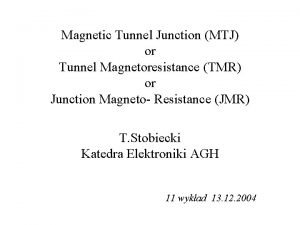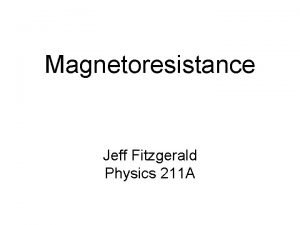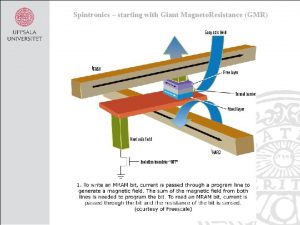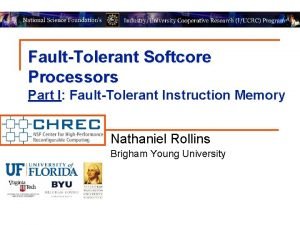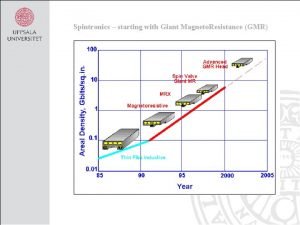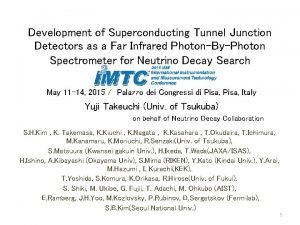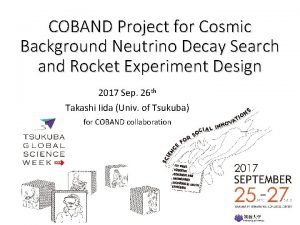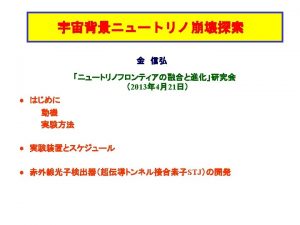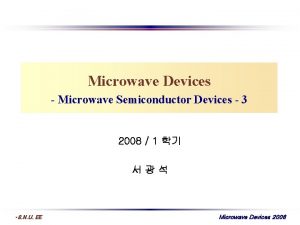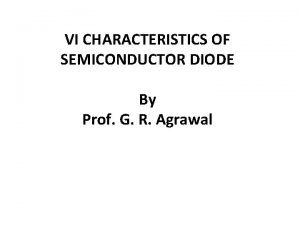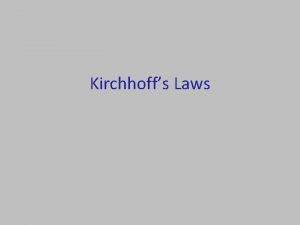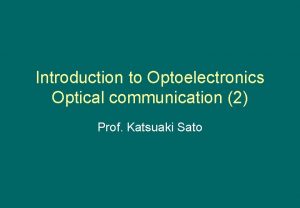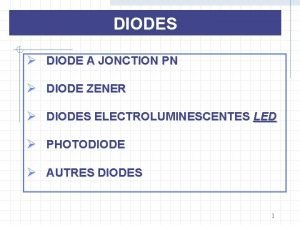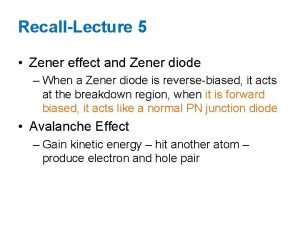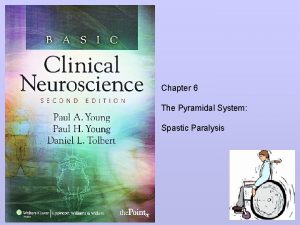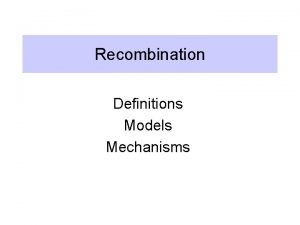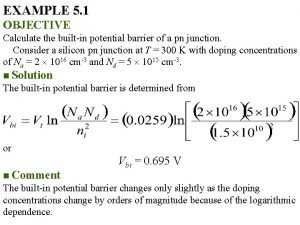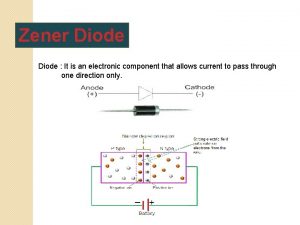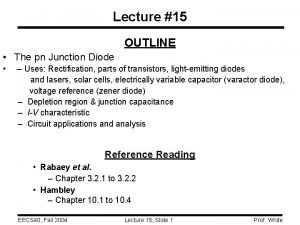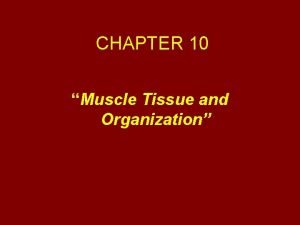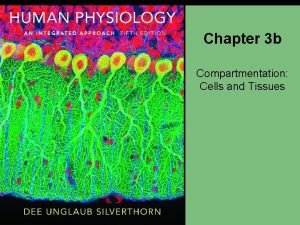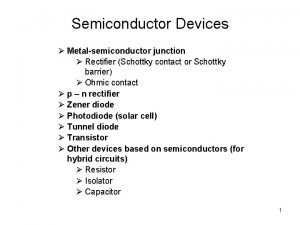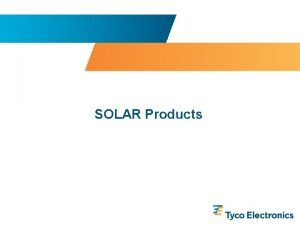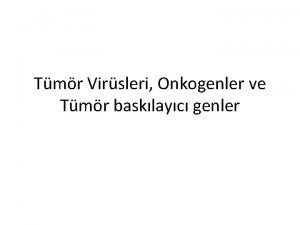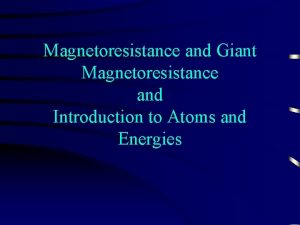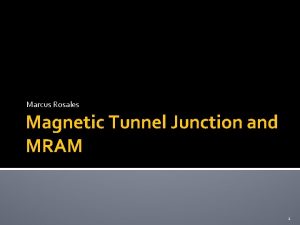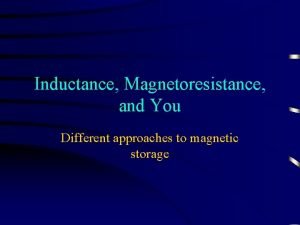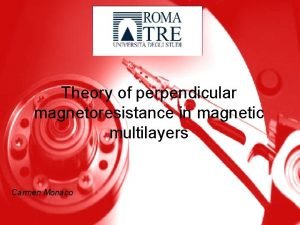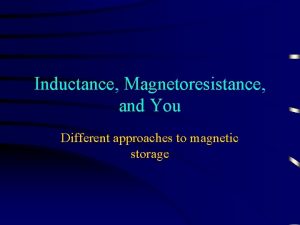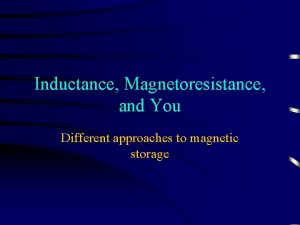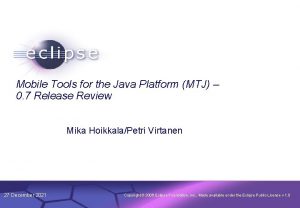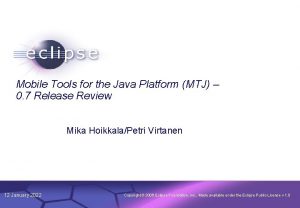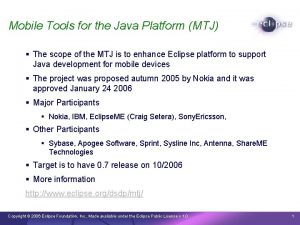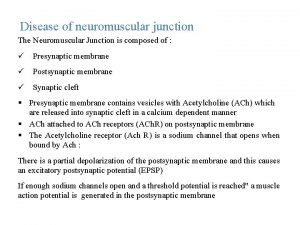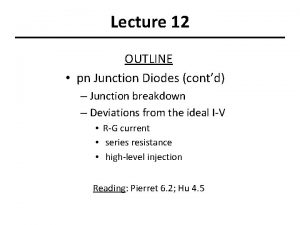Magnetic Tunnel Junction MTJ or Tunnel Magnetoresistance TMR








































- Slides: 40

Magnetic Tunnel Junction (MTJ) or Tunnel Magnetoresistance (TMR) or Junction Magneto- Resistance (JMR) T. Stobiecki Katedra Elektroniki AGH 11 wykład 13. 12. 2004










Spin Polarization, Density of States Spin Polarization Density of states 3 d Ferromagnetic metal (Fe) Material Polarizations Ni 33 % Co 42 % Fe 45 % Ni 80 Fe 20 48 % Co 84 Fe 16 55 % Co. Fe. B 60% Normal metal (Cu)


Tunneling in FM/I/FM junction FM I (PI) FM II (PII) e. V Barrier





Type of MTJs Standard junction Spin valve junction (SV- MTJ) Double barrier junction FM FM FM I I I FM FM AF I B FM

Application-Oriented Properties of S-V MTJ Materials SV-MTJ • I (Al-O, Mg. O. . ) Treatment • FM (Co, Co. Fe, Ni. Fe) Preparation • Annealing • AF (Mn. Ir, Pt. Mn, Ni. O) • Sputtering deposition • Field cooling • Buffer (Ta, Cu, Ni. Fe) • Oxidation Electric • Tunnel Magnetoresistance -TMR • Resistance area product -Rx. A Magnetic • Interlayer coupling field HS • Exchange bias field HEXB • Coercive field pinned HCP and free HCF layer • Switching field HSF

Magnetic and Electric Parameters FM I (Free) I Exchange coupling HEXB HCF HS HCP HEXB HSF switching fields FM II (Pinned) AF B Interlayer coupling HS

Applications of SV-MTJ SENSORS M-RAM SV-MTJ SPIN-LOGIC READ HEADS

SV-MTJ Based MRAM Writing - rotation of the free layer Reading - detection of a resistance of a junction Critical switching fields Hx , Hy (S-W) asteroid 1 Hy/H(0) SV- MTJ as MRAM component must fulfill requirements - Thermal stability - Magnetic stability - Single domain like switching behaviour - Reproducibility of Rx. A, TMR and Asteroids 0 Motorola: S. Tehrani et al. PROCEEDINGS OF THE IEEE, VOL. 91, NO. 5, MAY 2003 -1 -1 0 1

- Non-volatility of FLASH with fast programming, no program endurance limitation - Density competitive with DRAM, with no refresh - Speed competitive with SRAM - Nondestructive read - Resistance to ionization radiation - Low power consumption (current pulses) Features of M-RAM • Single 3. 3 V power supply • Commercial temperature range (0°C to 70°C) • Symmetrical high-speed read and write with fast access time (15, 20 or 25 ns) • Flexible data bus control — 8 bit or 16 bit access • Equal address and chip-enable access times • All inputs and outputs are transistor-transistor logic (TTL) compatible • Full nonvolatile operation with 10 years minimum data retention Motorola: S. Tehrani et al. PROCEEDINGS OF THE IEEE, VOL. 91, NO. 5, MAY 2003

SV-MTJ Based Spin Logic Gates VOUT= IS(RMTJ 3 + RMTJ 3 – RMTJ 1 – RMTJ 2) SV- MTJ as spin logic gates must fulfill requirements - Thermal stability - Magnetic stability - Centered minor loop - Single domain like switching behaviour - Reproducibility of R, TMR Siemens & Univ. Bielefeld: R. Richter et al. J. Magn. Mat. 240 (2002) 127– 129

Features of Spin Logic Gates - Programmable logic functions (reconfigurable computing) - Non-volatile logic inputs and outputs - Fast operation (up to 5 GHz) - Low power consumption - Compatibility to M-RAM

SV-MTJ Based Read Heads SV-MTJ as a read sensor for high density (> 100 Gb/in 2) must fulfill requirements - Resistance area product (Rx. A) < 6 - m 2 - High TMR at low Rx. A

A MTJs. Experiments on SV -MTJs B MTJs Ta 5 nm Au 25 nm Ni. Fe x nm Ta 3 nm Junction Cu 30 nm Co. Fe 2. 5 nm 0 10 30 60 100 Al 2 O 3 1. 4 nm Junctions size (180 180) m 2 Co. Fe 2. 5 nm Ta 5 nm Mn. Ir 10 nm Ni. Fe 3 nm Cu 5 nm Junction Al 2 O 3 1. 4 nm Co. Fe t nm Mn. Ir 12 nm 3 6 10 30 50 Ni. Fe 2 nm Ta 5 nm Cu 10 nm Cu 25 nm Ta 5 nm Substrate Si (100) Si. O 2 Substrate Si (100) A structure prof. G. Reiss laboratory University Bielefeld B structure prof. T. Takahasi laboratory, Tohoku University 10 mm

Effect of Annealing on TMR As deposited H=80 k. A/m 10 mm annealing 1 hour in vacuum 10 -6 h. Pa Annealed

Interlayer and Exchange Coupling Fields Exchange coupling fields A MTJs Interlayer coupling fields B MTJs

Interlayer and Exchange Coupling Fields

Temperature Dependence of TMR P. Wiśniowski, M. Rams, . . . Temperature dependence of tunnel magnetoresistance of Ir. Mn based MTJ, phys. stat. sol (2004)

Total Conductance Varies slightly with T Negligible Varies with T as magnetization does Bloch law Dominant

Polarization, Bloch Law 1. Set H= – 2000 Oe 2. Cooling H= 500 Oe 1. Set H= – 2000 Oe 3. Measured M (T) 2. Cooling H= – 500 Oe 3. Measured M (T) P 100 nm AP

Spin Independent Conductance Hopping conductance, high level of defects Hopping conductance, low level of defects

TIMARIS: Tool status Tool #1 – process optimization on 200 mm wafers since mid of March 03 Tool #2 – The Worlds 1 st 300 mm MRAM System is Ready for Process in August 03 Clean room Multi (10) Target Module Oxidation / Pre-clean Module Transport Module


Sputtering System LL1: wafer-in Plasma Oxidation LL2: Bridge Metal depo. Reactive sputter : surface smooth


MOKE Measurements R-VSM

MOKE with Orthogonal Coils
 Mtj junction
Mtj junction Ordinary magnetoresistance
Ordinary magnetoresistance Giant magnetoresistance basics
Giant magnetoresistance basics Tmr
Tmr Tmr records
Tmr records Giant magnetoresistance basics
Giant magnetoresistance basics Whats a conjunction
Whats a conjunction Stj
Stj Coband
Coband Superconducting tunnel junction
Superconducting tunnel junction Superconducting tunnel junction
Superconducting tunnel junction Wb magnetic flux
Wb magnetic flux Magnetic moment and magnetic field relation
Magnetic moment and magnetic field relation Force on a charged particle
Force on a charged particle Difference between antiferromagnetism and ferrimagnetism
Difference between antiferromagnetism and ferrimagnetism How is zener diode different from pn junction diode
How is zener diode different from pn junction diode Site:slidetodoc.com
Site:slidetodoc.com Define cell junction
Define cell junction Loop rule and junction rule
Loop rule and junction rule Cell junction
Cell junction End plate potential
End plate potential Sequence of events at the neuromuscular junction
Sequence of events at the neuromuscular junction N
N Pn junction diode, converts
Pn junction diode, converts Focus figure 9.1 events at the neuromuscular junction
Focus figure 9.1 events at the neuromuscular junction Jonction pn
Jonction pn P-n junction diode as half wave rectifier
P-n junction diode as half wave rectifier Electric field pn junction
Electric field pn junction Spinomedullary junction
Spinomedullary junction Good morning priti
Good morning priti Histodifferentiation stage of tooth development
Histodifferentiation stage of tooth development Break definition
Break definition Built-in potential
Built-in potential Pn junction diode, converts
Pn junction diode, converts Transistor animation
Transistor animation Pn junction diode circuit
Pn junction diode circuit Neuromuscular junction
Neuromuscular junction Cell-cell junction
Cell-cell junction Shottky contact
Shottky contact Solarlok combiner box
Solarlok combiner box Pavement bondi junction
Pavement bondi junction
